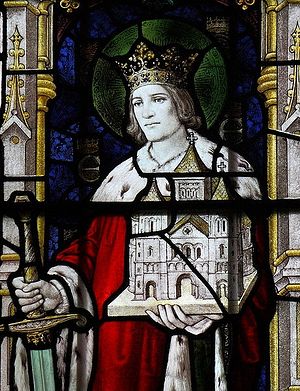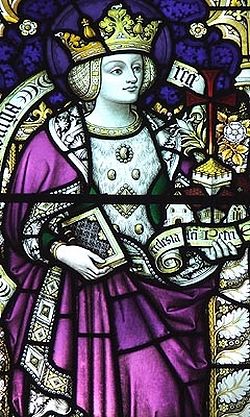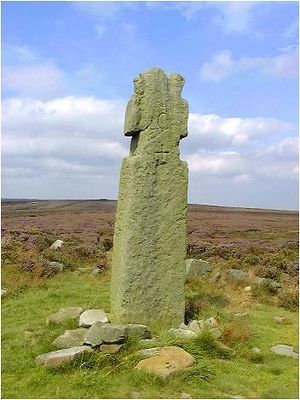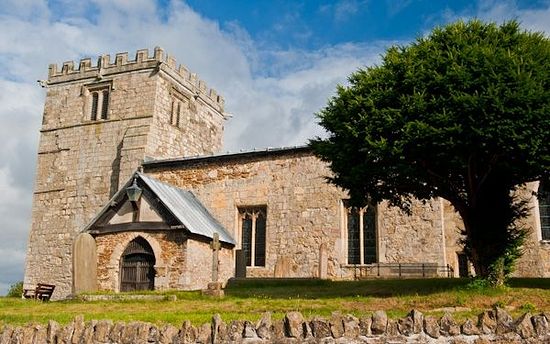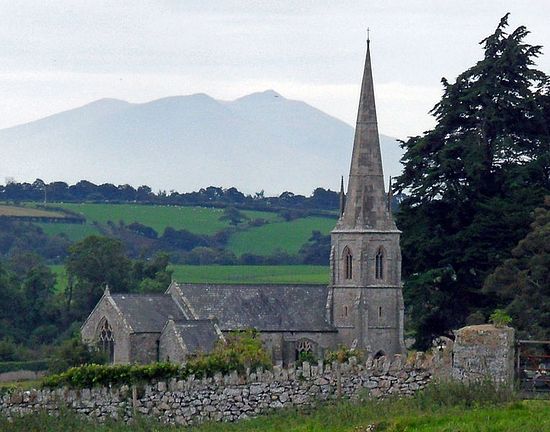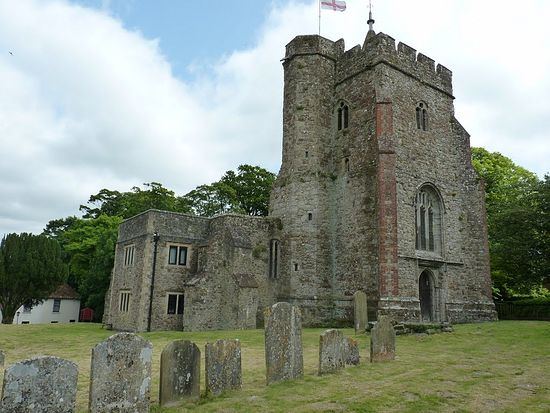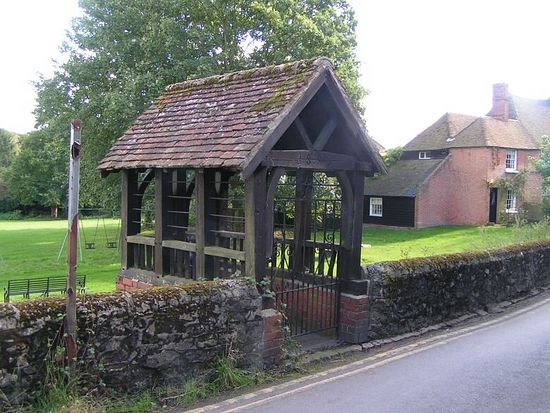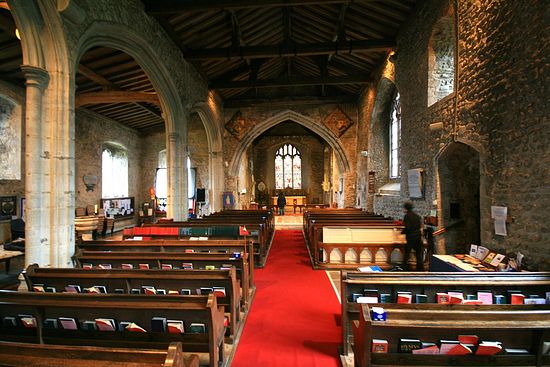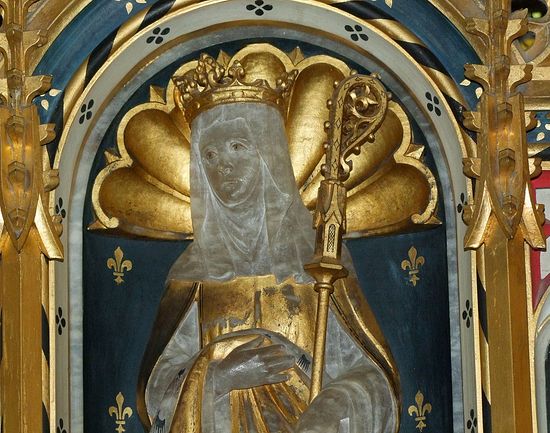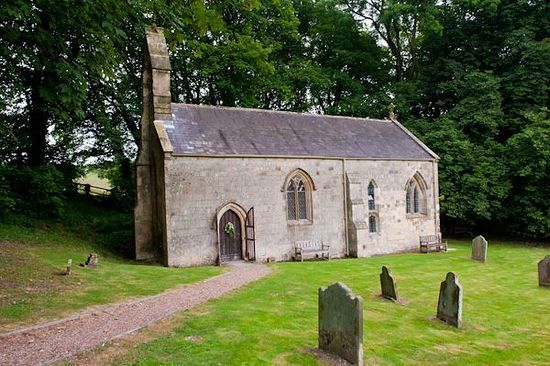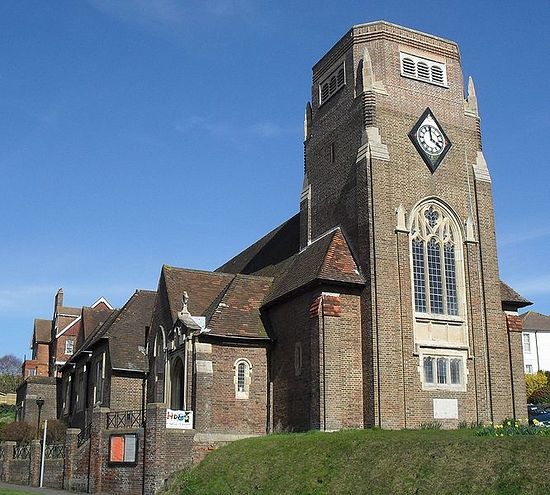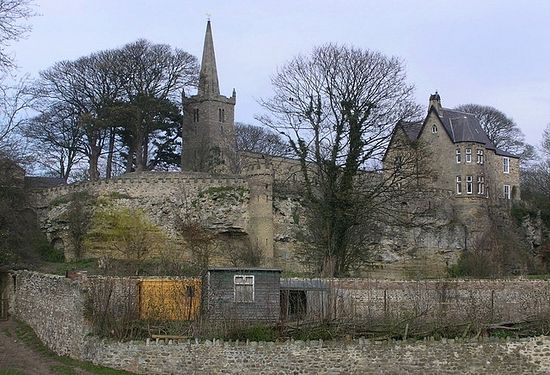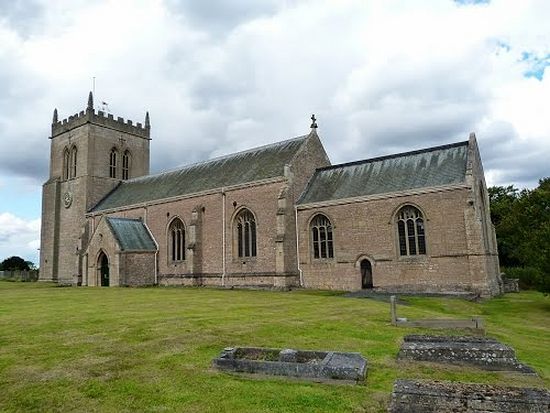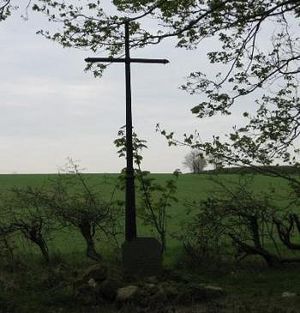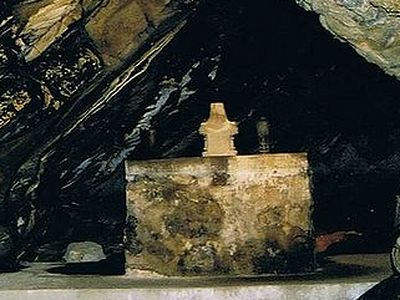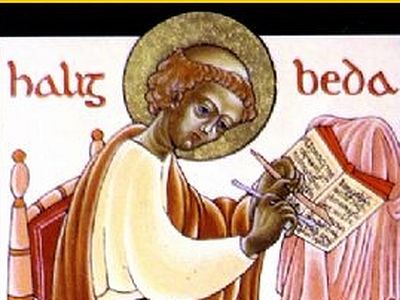By the time of the repose of St. Augustine of Canterbury in 604 there was only one kingdom in the whole of England that had been converted to Christianity—the Kingdom of Kent. The rest of the country was still pagan. The ferocious pagan called Penda soon afterwards began to rule over the Kingdom of Mercia in present-day central England. The northeastern part of the country then was called Northumbria, which was later ruled by Edwin, who was still a pagan but who was destined to become one of the apostles of his Kingdom. Let us now recall his life.
St. Edwin was born in about 585 a prince of the royal house of Deira, a kingdom in Yorkshire in the north of England. His father was Aella, the first certain king of Deira. When Edwin was a very young man he was driven away from Deira by Ethelfrith, king of Northumbria, which at that time corresponded to the county of Northumberland and some neighboring counties. Edwin had to spend many years in exile: first in Wales and then in the Kingdom of East Anglia where he found refuge at the court of King Redwald. But even there the life of Edwin was not quiet, as the emissaries of Ethelfrith spied on him all the time and he could have been put to death at any moment. At a young age Edwin married Princess Cwenburgh of Mercia and they had two sons.
One night, when he was still in exile, Edwin was sitting at the entrance to the palace in a state of distress. At that moment a stranger passed by. Suddenly he stopped and told Edwin to recover his spirits, saying: “If you will follow the piece of advice that will be given you one day, then not only will you get your kingdom back, but you will also receive true happiness”. And he laid his hands on his head. Edwin did not understand the meaning of these words that night but he memorized them forever.
A significant event happened in the life of St. Edwin in 616: with the support of his faithful friend, King Redwald, St. Edwin defeated and killed King Ethelfrith in battle at the River Idle, thus himself becoming King of Northumbria. But he remained a pagan all the same. By that time Edwin’s first wife, Cwenburgh, was dead, dying young, and Edwin sent an embassy to the new Kentish King Eadbald with a request to take his (Eadbald’s) sister Princess Ethelburgh as his wife. St. Ethelburgh (also known as Ethelburga or Tata; feast: April 5/18) was born late in the sixth century and was the daughter of the holy King Ethelbert of Kent, the first Christian king in England and the Baptizer of Kent.
The young Ethelburgh was raised as a Christian and lived in great piety. Her mother was the Merovingian Princess Bertha, who had married St. Ethelbert and as queen contributed to the conversion of her husband to Christianity and introduction of the faith of Christ in Kent. In her turn, Ethelburgh was destined by the Lord to contribute to her husband Edwin’s and his court’s conversion to Orthodoxy and introduction of this religion in Northumbria and the north of England. So, Eadbald first answered Edwin that it was against the law for a pagan to take a Christian girl as his spouse. Then Edwin, remarkably, made the same pledge which once St. Ethelbert had given before marrying the Christian Princess Bertha: he pledged not to interfere in the spiritual life of his wife and her relatives; and if he was to find that Christianity was a holier and more virtuous faith than the heathenism that he confessed, then he would embrace this faith himself. So the king consented to all the demands.
Thus the holy virgin and princess Ethelburgh was sent in about 625 to Northumbria together with her spiritual father—the saintly priest (and in the same year, bishop) Paulinus, a member of the second group of missionaries sent by Pope Gregory the Great in 601 to England from Italy, and who was to become an illustrious bishop of York. It was known that St. Paulinus planned to enlighten Northumbria. The young Ethelburgh may have been at first a little hesitant to go to faraway Northumbria, but Pope Boniface wrote her a letter of encouragement with his blessing and gifts: a mirror of silver along with an ivory comb adorned with gold.
Edwin had already heard about the Christian faith; he was sympathetic to it, considered it to be better than his paganism and wanted to learn more about this religion. But he took his time and did not hurry to accept Orthodoxy: Edwin was a considerate and sober-minded man and tried to avoid hasty decisions. The ruler thought that if ever he was to embrace Christianity, then he would be joined by all his retinue and the whole of his nation. The three successive events that then followed led to the king’s decision to become a follower of Christ the Savior forever.
Firstly, there was the unsuccessful attempt of King Cwichelm of the West Saxons to murder Edwin, in which he saw the hand of God. An assassin was sent to Edwin on Easter eve, 626. The assassin tried to plunge his double-edged poisoned dagger into St. Edwin’s body but only wounded him. At that very moment Lilla, Edwin’s most faithful servant, placed himself between the king and the assassin and thus died, while Edwin remained alive.1 The king’s men killed the assassin at once. St. Edwin thanked the pagan gods for saving him in this incident but St. Paulinus, hearing this, revealed to him that he himself together with Queen Ethelburgh had been praying for Edwin to Chris,t and it was the Christian God who had saved him.
Edwin was greatly amazed and began to look on Christianity more favorably and, as his and Ethelburgh’s daughter Enfleda was born on the same Easter night, while Ethelburgh had no pain in delivering, he allowed her to be baptized into Orthodoxy, which was done at the feast of Pentecost. The infant Enfleda was the first person in Northumbria to be baptized into Orthodoxy, and eleven of her relatives joined her. It was decided to dedicate the royal daughter to Christ. In the future this Enfleda became the wife of a king of Bernicia and later a nun at Whitby. She was venerated as a saint after her repose in about 704.
Soon the king’s wound was healed. Edwin no longer considered himself a pagan, yet he put off his conversion to Christianity. Very often he spent time alone in deep thought or conversation with his spouse Ethelburgh and the holy Bishop Paulinus, speaking with them on the meaning of life. He listened to both of them very attentively.
Secondly, it was the rejection of heathenism by Northumbria’s pagan high priest Coifi. This happened in the following way. Edwin finally decided to call a council of all his advisers and wise men. He also invited Paulinus to the assembly. He seriously wanted to find out the true faith as soon as possible. He wanted to hear what his elders were going to tell him about this. Everybody listened to the story of Paulinus about the Orthodox faith with due attention. Then the high priest said that he did not believe in the pagan idols any longer as they had never rescued him from any danger, and that he was nearly ready to accept Christianity himself. Another wise man said that he saw our earthly life like a sparrow who for a short time, protecting itself from the winter cold, flew into a brightly-lit and warm house through one door and soon flew out of it through another door, leaving no memory of itself. Other advisers also admitted that their old idols had no power. A temple devoted to a pagan deity stood behind the hall they gathered in.
So, the chief priest at one moment rose from his seat, approached the temple and, with the words, “If there is a god in this temple, then he will defend himself and kill me”, threw his sword inside the temple. But, of course, nothing happened after that. All the wise men who saw him do this, and Edwin with them, were really staggered. The chief priest then pierced the main idol in the temple with his lance, and it was decided to destroy and burn all old pagan temples in other places. Tradition says that this assembly was held in the present-day village of Goodmanham in East Riding of Yorkshire. It is said that it is here that the chief Northumbrian pagan temple dedicated to Woden stood, and it is this temple that was destroyed by Coifi. A church dedicated to All Saints (All Hallows) was erected on that spot in place of the temple, and this church, though later rebuilt, stands there to this day. Soon after that, Pope Boniface sent his letter with St. Peter’s blessing to Edwin, calling upon him to accept the true Orthodox faith and giving him a shirt with a golden ornament and a garment from Ancyra as gifts.
And, thirdly, as the Lord had bestowed the gift of clairvoyance on His servant Paulinus, the latter knew the past life of Edwin. So he reminded Edwin of his meeting with the stranger many years before, when he was in exile. Paulinus laid his hand on Edwin’s head (as did that stranger) and gently advised him to live according to the Lord’s commandments henceforth. The bishop said that the Lord had once delivered Edwin from his enemies and granted him a large kingdom, and that the same Lord will grant him eternal life, should he believe in Christ. Edwin was stricken with awe and reverence. Meanwhile, most of the advisers were already suggesting that Edwin accept baptism. So Edwin firmly decided to become a Christian.
On Easter Sunday, April 12, 627, Edwin with all his retinue, many family members and friends were baptized in the wooden church of St. Peter in York by St. Paulinus. Soon after that, many of the king’s subjects—hundreds of common people from what is now both Yorkshire and Lincolnshire—voluntarily followed their ruler’s example and were baptized. The mass baptism took place in the River Swale. That was the most significant event.
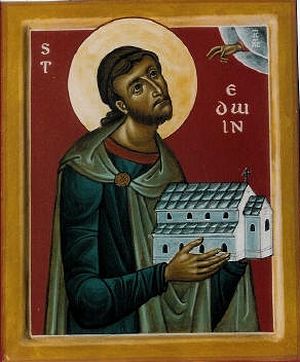 Icon of St. Edwin of Northumbria
Icon of St. Edwin of Northumbria
Edwin tried his best to support Paulinus in the enlightenment of his native kingdom Northumbria. The Roman city of York was chosen for Paulinus as his episcopal see. Edwin undertook the construction of a splendid large stone church in York himself, though it was completed after his martyrdom, under his successor, St. Oswald. Edwin’s zeal for the spreading of truth was so strong that he persuaded Eorpwald, King of the East Angles and son of Redwald, to abandon his idolatrous superstitions and receive the faith of Christ.
At the same time, Pope Honorius, the successor of Boniface, learning about the baptism of Northumbria, sent an episcopal pallium to Paulinus and a letter to Edwin, which, among other things, read, “O noble Christian Lord, your zeal for the worship of God is so inflamed in the fire of faith that it shines out far and wide… and brings forth the plentiful fruit of your labors. You know that you are a king because you believe in God the Almighty, as true teaching instructs, and are serving Him with a pure heart (quoted by Bede).”
Indeed Edwin performed great services for his homeland which under his rule expanded. Thus, during his reign the Picts in the north (south Scotland) were already under his power, as were the inhabitants of Wales and Cumbria in the west (he had taken the isles of Anglesey and Man from the Welsh), areas around the present-day city of Leeds and even the southern lands of England. In general, most of the English and the Britons (except those from Kent) submitted to him as a Christian king. Bede says that Edwin was the fifth bretwalda in England—a king who achieved overlordship of all or most of the lands of Britain in the time of Heptarchy. But Edwin gained power over even more lands than did any of his predecessors. However, this was not to last long.
At that time the pagan Mercian king Penda declared war on Edwin and pledged to bring the whole of Edwin’s nation back to paganism and the old idols. Allied with the Welsh King Cadwalla who was a Christian in name only, Penda defeated the Northumbrian army and murdered Edwin on October 12 (October 25 new style), 633, invading his entire kingdom. This happened in the place known as Hatfield (probably in south Yorkshire). One of Edwin’s sons named Osfrid was killed in the same battle, and another son, Eanfrid, was kidnapped by Penda and soon put to death. King Edwin then was only about 48 years old. He ruled over Northumbria for seventeen years and for six of them he was a true warrior of Christ. Then by order of Penda and Cadwalla, barbarous cruelties began, as writes Bede, “they neither spared the female sex, nor the innocent age of children, but with savage cruelty put them to tormenting deaths, ravaging all their country for a long time”. They did not allow any citizens to profess their Christian faith throughout the country either. And this continued until the holy King Oswald crushed the pagans in 635.
Despite the fact that Edwin became a martyr for Christ and the first English king to be slain for Christ, the country for some time returned to idolatry. It was partly for fear of King Penda and partly because the Northumbria of St. Edwin was a newly-baptized state and its people had no time to grow and strengthen in faith. Only a handful of fearless oppressed missionaries stayed in Northumbria at that troubled period. Among them we can mention the holy Deacon James of York who continued his ministry at daily risk to his life.
After the murder of Edwin, St. Paulinus took the widowed Queen Ethelburgh together with her infant children2 and other relatives back to Kent where Paulinus served as Bishop of Rochester until his repose in 644. From Northumbria Paulinus also brought a large gold cross and a golden chalice, dedicated to the use of the altar, which at the time of Bede were preserved in the church of Canterbury. As for St. Ethelburgh, the Kentish royal legend in the eleventh century recorded that she became a nun upon her return to her native Kent. As St. Bede relates, she also sent her little son together with her stepson’s infant child (they were named Uscfrea and Yffi) to Gaul, to be educated at King Dagobert’s court, where, however, they soon died. Then King Eadbald of Kent, brother of Ethelburgh, gave her land in the place called Lyminge in Kent, close to the port of Folkestone, where the holy woman founded a double monastery in honor of the Mother of God. She became its first abbess and zealously ruled it until her repose, which took place on the feast of the Nativity of the Mother of God (September 8/21) in about 647.
Recent extensive research work carried out inside and near Lyminge church shows that the monastery founded by Ethelburgh was built from Roman materials and partly from the fabric of an earlier villa that used to stand on that site. Later Ethelburgh was canonized as a saint of God for her many labors of introducing and spreading Christianity in the north of England as well as in Kent. Her monastery existed in Lyminge for three centuries; its life was first stopped by the Danish raids in the ninth century when the nuns fled to Canterbury. In the tenth century the monks also left, and there has been only a parish church on this site since then. This fine and interesting church in honor of the Mother of God and St. Ethelburgh stands there to this day as a gem and attracts pilgrims.
The relics of St. Ethelburgh were most probably translated from Lyminge to Canterbury in the late eleventh century by Archbishop Lanfranc and placed in the newly-established collegiate church, where they remained until the Reformation. A recess (made up of two pointed arches) in the south wall of Lyminge church is the exact original location of the shrine of St. Ethelburgh—this place can be viewed from inside the church as a recess and from outside as a separate ancient stone. This south wall of the present church may have been the north wall of the original church. A part of the fabric of this church is late Saxon (chancel and nave) and even Roman, so this church is a very unique holy place. Significantly, there are a number of tenth century Saxon round-headed windows inside the church dating to the time of St. Dunstan of Canterbury, who rebuilt the church in about 965. The reredos (the screen behind the altar) of this church was designed by the British architect and stained-glass maker Sir Ninian Comper (1864-1960). The figures on the reredos are of the Mother of God with the Christ Child, St. Ethelburgh, St. Paulinus, and St. Dunstan. The church also contains a stained glass depicting its patroness Ethelburgh along with a banner of this royal abbess among its relics. There is a holy well in honor of St. Ethelburgh (at the source of the local river) near this church, which has curative properties. The latest excavations have revealed the outline of the original Saxon monastery with some interesting details and finds. The site of the first Saxon church was excavated in the nineteenth century to the south from the church and the visible remains of that can be viewed to the east of the church porch.
At least two other parish churches are dedicated to St. Ethelburgh. The first one is situated in the village of Great Givendale in the East Riding of Yorkshire. This very small church is hidden below a wooded slope in a very picturesque place. It was built in Norman times and rebuilt in the nineteenth century, and is richly decorated inside. Another, modern church in her honor, is located in St. Leonards-on-Sea (now a district of the town of Hastings) in East Sussex. In the early English Church there were three more saints with the name “Ethelburgh”: Ethelburgh the first, seventh century, Abbess of Barking near London and sister of St. Erconwald of London (+ c. 675); Ethelburgh, a daughter of King Anna of East Anglia and later Abbess of Faremoutiers in Gaul (+ c. 664); and Ethelburgh, wife of the holy King Ine of Wessex—both of them moved to Rome in 726 where they took monastic vows and reposed.
Now let us speak a little about the veneration of St. Edwin. After his death the people began to venerate him as a martyr, a national hero and an exemplary Christian ruler. According to tradition, for some time the relics of St. Edwin were hidden in a church in Sherwood Forest, and that site was later called “Edwinstowe” (now a village with the same name) in honor of the saint. It is located in the county of Nottinghamshire. With time, after a miraculous revelation, his relics were found. His head relic was translated to the city of York (and placed inside St. Peter’s stone basilica, which Edwin had started building), and the rest of the body was sent to Whitby. From that time on, York and Whitby were the main centers of veneration of Edwin. And this is just because Edwin himself began building the first stone church in the whole of England in York (all other churches at that time were wooden), while his daughter St. Enfleda and granddaughter St. Elflaed were to become the successive abbesses of Whitby.
Whitby was also the burial site of members of the royal family of Deira (from which Edwin descended). Now York Minster, reputed to be the second largest Gothic cathedral in Europe, is the successor of the original church connected with Edwin. A parish church in the village of High Coniscliffe in County Durham is dedicated to St. Edwin. This church is unusually long; some parts are of the Norman and later medieval periods. Several Saxon carvings can be found inside the church. St. Edwin is depicted on a stained glass window in St. Mary’s Church in Sledmere, in the East Riding of Yorkshire. He is also depicted on the wall-paintings of the English College in Rome.
***
Over the past 150 years, the relics of a number of early English saints have either been miraculously rediscovered or returned to England from other countries. There are numerous cases of miracles through these saints’ prayers and apparitions of them to people. Thus, St. Botolph of Iken more than once rescued travelers from imminent death in a visible way; the residents of the tiny town Dorchester-on-Thames near Oxford, where relics of the Apostle of Wessex St. Birinus are kept in the abbey church, have seen him at night walking along the streets as if guarding his flock; likewise, residents of Beverley near York have seen the holy Hierarch and Wonderworker John of Beverley walking in the town. He is a great intercessor for his people who saved the place from destruction many times; the Venerable Bede has appeared to people (including one Orthodox bishop) near his shrine at Durham Cathedral; miracles, including a vision of an angel, have occurred in the Church of St. Mary in Lastingham where the relics of St. Cedd of Essex rest. And these are only some cases of miracles. Also, in 2013, the possible relics of the Holy and Righteous King Alfred the Great were uncovered in the church of St. Bartholomew in Winchester. These remains are now being examined by scientists. The Lord is speaking to us through His faithful servants in our difficult and unstable times, when many people and even entire nations urgently need to remember and return to the life and merits of their pious, Orthodox forebears.
One of the next revelations, we believe, will be a miracle connected with St. Edwin, one of the first Christian kings of Britain who gave his life for Christ in battle with pagans. Two years ago a group of archaeologists started large-scale work in the village of Cuckney (also Norton Cuckney) near the town of Mansfield in Nottinghamshire, where workers under the Norman Church of the Mother of God had discovered earlier skeletons dating from the Saxon period. All of them lay in rows, feet facing eastwards, about 200 in number, and, to all appearance, are skeletons of soldiers.
It was thought (though not proved) that the Battle of Hatfield in which Edwin was slain took place in the area known as Hatfield Chase in South Yorkshire, not far from the town of Doncaster (now it is low-lying land called Hatfield Chase). But there always existed an alternative version that the battle took place in a field near Cuckney in Northamptonshire. In ancient times this spot also was called “Hatfield”, and the village of Edwinstowe, mentioned above, is only a few miles away (there stands the early twentieth century St. Edwin’s cross on the site marking a chantry chapel in honor of the saint, in which medieval hermits used to pray during the reign of King John and until the Reformation).
Several experts are convinced that the graves found under Cuckney church belong precisely to the soldiers who fell in the battle of 633, and the relics of St. Edwin (though this is less probable) may be among them. In ancient times, people used to build churches right on battlefields and above mass graves in the memory of fallen warriors. Modern radiocarbon investigation of the skeletons along with a more thorough examination of the area will help experts to ascertain the facts. We may soon know whether this find is the exact site of the martyrdom of St. Edwin, whose missionary labors and Christian sacrifice played an important role in the establishment of the Church in the north of England, from where, thanks to such missionaries as St. Aidan, Orthodoxy spread to other regions of England and even abroad.
Holy King Edwin of Northumbria and Holy Queen-Abbess Ethelburgh, pray to God for us!
